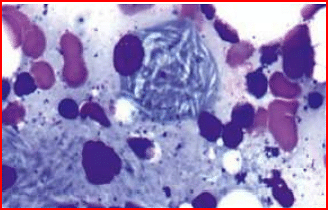Question:
A child presents with bone pain and hepatosplenomegaly. A trephine biopsy and aspirate show the following finding. Which of the following is the most likely enzyme deficient in this condition?

A child presents with bone pain and hepatosplenomegaly. A trephine biopsy and aspirate show the following finding. Which of the following is the most likely enzyme deficient in this condition?


Updated On: Jun 19, 2025
- Hexosaminidase
- Glucocerebrosidase
- Sphingomyelinase
Alpha 1,4-glucosidase
Hide Solution
Verified By Collegedunia
The Correct Option is B
Solution and Explanation
A child presents with bone pain and hepatosplenomegaly, which are key symptoms suggestive of a lysosomal storage disorder. The trephine biopsy and aspirate findings further point towards a specific enzyme deficiency. Given the options, we need to identify which enzyme deficiency correlates with these clinical features. Let's evaluate each option:
- Hexosaminidase: Deficiency causes Tay-Sachs disease, typically characterized by neurological symptoms, not bone pain or hepatosplenomegaly.
- Glucocerebrosidase: Deficiency results in Gaucher's disease, known for symptoms such as bone pain, hepatosplenomegaly, and the presence of Gaucher cells in bone marrow.
- Sphingomyelinase: Deficiency leads to Niemann-Pick disease, which includes neurological symptoms and hepatosplenomegaly, but bone pain is less common.
- Alpha 1,4-glucosidase: Deficiency results in Pompe disease, causing cardiomyopathy and muscle weakness, not typically bone pain or significant hepatosplenomegaly.
Based on the clinical presentation of bone pain and hepatosplenomegaly, the most likely enzyme deficiency is glucocerebrosidase, associated with Gaucher's disease. Thus, the correct answer is:
Glucocerebrosidase
Was this answer helpful?
0
0
Top Questions on Lipids
- A patient presents with xanthomas on the Achilles tendon. Which of the following is the most likely diagnosis?
- A patient with multiple tendon xanthomas is found to have a serum cholesterol level of 398 mg/dL and an LDL level of 220 mg/dL. What is the most likely defect?
- Which of the following has the lowest melting point?
- Ceramides are
- A child presents with mental retardation, bone pain, and inability to walk. On funduscopic examination, a cherry red spot is seen. There is no organomegaly. What is the most likely diagnosis?
View More Questions
Questions Asked in NEET PG exam
Which of the following cranial nerves is responsible for the motor innervation of the muscles of mastication?
- NEET (PG) - 2025
- General Science
The normal pH of arterial blood is:
- NEET (PG) - 2025
- General Science
Which enzyme is deficient in Gaucher’s disease?
- NEET (PG) - 2025
- General Science
The anticoagulant effect of heparin is monitored using:
- NEET (PG) - 2025
- General Science
The causative agent of malaria is:
- NEET (PG) - 2025
- General Science
View More Questions